Abralia (Asteroteuthis) veranyi
Kotaro TsuchiyaIntroduction
A. veranyi is the sole member of the subgenus Asteroteuthis. It is one of the more widely distributed Abralia species in the Atlantic Ocean.
Brief diagnosis:
An Abralia with ...
- left arm IV hectocotylized.
- distal suckers on arms I-III in 3 - 4 series.
Characteristics
- Tentacle clubs
- Two or three hooks on ventral side.
- Two rows of large suckers on dorsal side of manus.
- Arms
- Tips of arms I-III with suckers in 3-4 series.
 Click on an image to view larger version & data in a new window
Click on an image to view larger version & data in a new window
Figure. Dorsal view of the arm crown of A. veranyi, female, 38 mm ML with a close-up insert of one arm tip. Note that only the very end of the sucker-bearing arm tip has photophores in 3-4 series. White arrows point to the most distal hook on several arms to indicate how short this tip is compared to the length of the sucker-bearing region. Note also the abrupt decrease in sucker size at the beginning of this tip.
- Left ventral arm of male hectocotylized.
- Hectocotylus with two different sized off-set flaps.
- Tips of arms I-III with suckers in 3-4 series.
- Eye Photophores
- Five complex organs: two large terminal opaque organs with three small silvery organs between them.
 Click on an image to view larger version & data in a new window
Click on an image to view larger version & data in a new window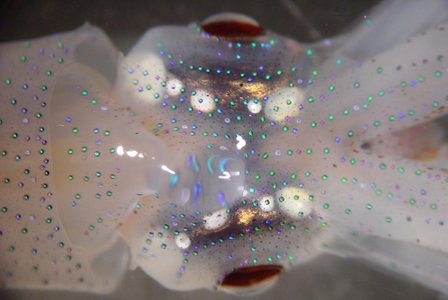
Figure. Ventral view of the head of a young A. veranyi, showing the ocular photophores (white) on the eyeballs and the overlying integumental photophores (green and purple). Note the distortion in the center caused by exhalent water from the funnel distorting the water surface in the dish containing the squid. Photograph by M. Vecchione.
- Five complex organs: two large terminal opaque organs with three small silvery organs between them.
- Integumental photophores
- Ventral mantle and head with scattered arrangement of integumental organs.
- Ventral mantle and head with scattered arrangement of integumental organs.
- Reproductive structures:
- Spermatangia receptacles. Modified tissue on the mantle, ventral to the gladius, and forward to cover part of the nuchal cartilage.
 Click on an image to view larger version & data in a new window
Click on an image to view larger version & data in a new window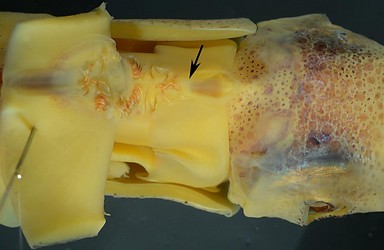
Figure. Dorsolateral view with mantle folded posteriorly of the spermatangia receptacles of A. veranyi. Note the large modified area on the underside of the mantle and the encroachment of modified tissue over part of the nuchal cartilage (arrow). This whole region has spermatangia attached.
- Spermatangia receptacles. Modified tissue on the mantle, ventral to the gladius, and forward to cover part of the nuchal cartilage.
Distribution
Vertical distribution
Two juvenile specimens were caught in daylight at 700-800m deep and in night at 60-20m in 10° N, 20° W by midwater tow (Lu & Clarke, 1975)
Geographical distribution
This species was originally described from the Mediterranean Sea. It is the most widely distributed member of the Atlantic Abralia species associated with the distant-neritic waters. Distribution, were known, is from the northern Sargasso Sea to Bear Seamount, Bahama Islands and northern Brasil in the West Atlantic, and south off France to Benguella water in the East Atlantic.
References
Lu, C. C. and M. R. Clarke, 1975. Vertical Distribution of cephalopods at 11° N 20° W in the North Atlantic. Journal of the Marine Biological Association of the United Kingdom, 55 (2): 369-389.
Title Illustrations

| Scientific Name | Abralia veranyi |
|---|---|
| Location | Western North Atlantic off the Bahamas |
| Specimen Condition | Live Specimen |
| View | Side |
| Image Use |
 This media file is licensed under the Creative Commons Attribution-NonCommercial License - Version 3.0. This media file is licensed under the Creative Commons Attribution-NonCommercial License - Version 3.0.
|
| Copyright |
©

|
About This Page

Tokyo University of Fisheries, Tokyo, Japan
Page copyright © 2018
All Rights Reserved.
- Content changed 21 January 2014
Citing this page:
Tsuchiya, Kotaro. 2014. Abralia (Asteroteuthis) veranyi . Version 21 January 2014 (under construction). http://tolweb.org/Abralia_%28Asteroteuthis%29_veranyi/19654/2014.01.21 in The Tree of Life Web Project, http://tolweb.org/





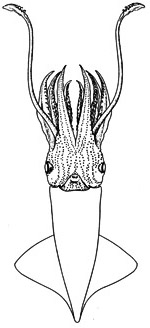
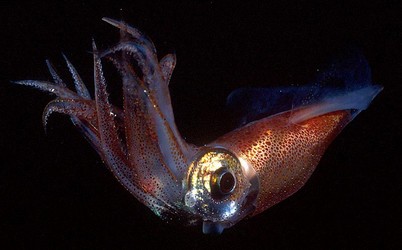


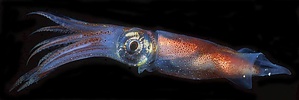



 Go to quick links
Go to quick search
Go to navigation for this section of the ToL site
Go to detailed links for the ToL site
Go to quick links
Go to quick search
Go to navigation for this section of the ToL site
Go to detailed links for the ToL site